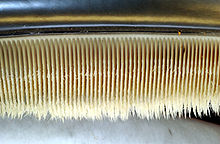Baleen whale
| Baleen whales Temporal range: latest Eocene - Recent
| |
|---|---|

| |
| Humpback Whale breaching | |
| Scientific classification | |
| Kingdom: | |
| Phylum: | |
| Class: | |
| Order: | |
| Suborder: | Mysticeti Cope, 1891
|
| Families | |
| Diversity | |
| [[List of cetaceans|Around 15 species; see list of cetaceans or below.]] | |

The baleen whales, also called whalebone whales or great whales, form the Mysticeti, one of two suborders of the Cetacea (whales, dolphins and porpoises). Baleen whales are characterized by having baleen plates for filtering food from water, rather than having teeth. This distinguishes them from the other suborder of cetaceans, the toothed whales or Odontoceti. Living Mysticeti species have teeth only during the embryonal phase. Fossil Mysticeti had teeth before baleen evolved.
Baleen whales are generally larger than toothed whales, and females are larger than males. This group comprises the largest living animal species, the Blue Whale. Baleen whales have two blowholes, causing a V-shaped blow.
The suborder contains four families and fourteen species. A list of species can be found below and at the Cetacea article. The scientific name derives from the Greek word mystax, which means "moustache".
Feeding
Baleen whales do not have teeth; instead they have baleen in the upper jaw. They engulf sea water containing crustaceans, then close their mouth and create internal pressure by raising their tongue toward the palate to push the water out through the 'comb' of baleen plates, trapping small ocean animals, especially krill and other plankton, inside.
This is called filter feeding. Even though individually the crustaceans are minuscule, baleen whales take in an enormous volume of water containing enough food to maintain their survival.
There are several types of food-finding methods:
- Gulpers (swallowers): alternate between swimming and opening their mouths, e.g. Blue Whales, Pygmy Blue Whales, Fin Whales, Bryde's Whales, Humpback Whales, and Minke Whales.
- Skimmers: predominantly have their mouths open while swimming, e.g. right whales, Pygmy Right Whales, and Bowhead Whales
- Benthic feeders: Gray Whales
- Combined: Sei Whales are both swallowers and skimmers
Behaviour
Breaching
In spite of their enormous mass, baleen whales are able to leap completely out of the water. Particularly known for their acrobatics are the Humpback Whales, but other baleen whales also break through the water surface with their body or beat it loudly with their fins. The reason for these habits is not known for certain, and was identified in three separate sightings.
Vocalizations
In contrast to toothed whales, baleen whales are unlikely to echo-locate. Instead they are able to produce high volume sounds in the infrasonic range. The calls of the largest whales can be heard several hundred kilometres away. Unique are the songs of the Humpback Whales, consisting of complex sequences that may slowly evolve over years. They are probably used for courting.
Human interaction
In the 19th and early 20th centuries, baleen whales were hunted for their oil and baleen. Their oil can be made into margarine and cooking oils. Baleen was used to stiffen corsets, as parasol ribs and to crease paper.
Evolution of Baleen whales
Early baleen whales first appeared as far back as Early Oligocene, or perhaps the latest Eocene (39-29 million years ago). Early baleen whales did not have (or had very little) baleen, but still had teeth obtained from their ancestors. Among them was Janjucetus, a baleen whale with sharp teeth that hunted fishes, squid, and large prey such as sharks and probably dolphin-like cetaceans. This hints that early baleen whales were predatory and eventually evolved into the gentler, toothless whales known today. The first baleened, toothless baleen whales probably appeared in the Early or Middle Miocene, from a toothed ancestor that adapted to eat small fishes or other creatures and eventually to feed by filtering.
Taxonomic classification
- ORDER CETACEA
See also
